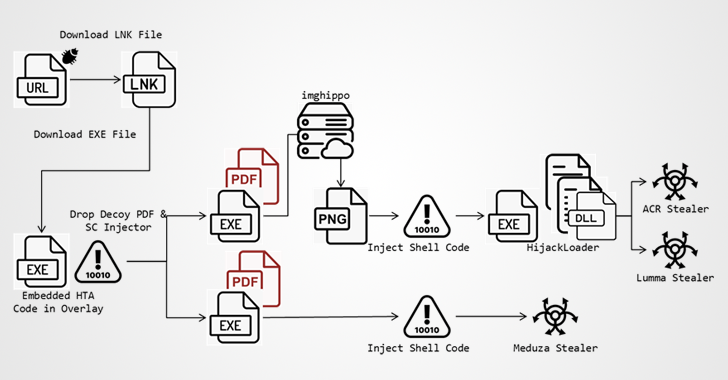A now-patched security flaw in the Microsoft Defender SmartScreen has been exploited as part of a new campaign designed to deliver information stealers such as ACR Stealer, Lumma, and Meduza.
Fortinet FortiGuard Labs said it detected the stealer campaign targeting Spain, Thailand, and the U.S. using booby-trapped files that exploit CVE-2024-21412 (CVSS score: 8.1).
The high-severity vulnerability allows an attacker to sidestep SmartScreen protection and drop malicious payloads. Microsoft addressed this issue as part of its monthly security updates released in February 2024.
“Initially, attackers lure victims into clicking a crafted link to a URL file designed to download an LNK file,” security researcher Cara Lin said. “The LNK file then downloads an executable file containing an [HTML Application] script.”

The HTA file serves as a conduit to decode and decrypt PowerShell code responsible for fetching a decoy PDF file and a shellcode injector that, in turn, either leads to the deployment of Meduza Stealer or Hijack Loader, which subsequently launches ACR Stealer or Lumma.
ACR Stealer, assessed to be an evolved version of the GrMsk Stealer, was advertised in late March 2024 by a threat actor named ShieldIO on the Russian-language underground forum RAMP.
“This ACR stealer hides its [command-and-control] with a dead drop resolver (DDR) technique on the Steam community website,” Lin said, calling out its ability to siphon information from web browsers, crypto wallets, messaging apps, FTP clients, email clients, VPN services, and password managers.
It’s worth noting that recent Lumma Stealer attacks have also been observed utilizing the same technique, making it easier for the adversaries to change the C2 domains at any time and render the infrastructure more resilient, according to the AhnLab Security Intelligence Center (ASEC).
The disclosure comes as CrowdStrike has revealed that threat actors are leveraging last week’s outage to distribute a previously undocumented information stealer called Daolpu, making it the latest example of the ongoing fallout stemming from the faulty update that has crippled millions of Windows devices.
The attack involves the use of a macro-laced Microsoft Word document that masquerades as a Microsoft recovery manual listing legitimate instructions issued by the Windows maker to resolve the issue, leveraging it as a decoy to activate the infection process.
The DOCM file, when opened, runs the macro to retrieve a second-stage DLL file from a remote that’s decoded to launch Daolpu, a stealer malware equipped to harvest credentials and cookies from Google Chrome, Microsoft Edge, Mozilla Firefox, and other Chromium-based browsers.
It also follows the emergence of new stealer malware families such as Braodo and DeerStealer, even as cybercriminals are exploiting malvertising techniques promoting legitimate software such as Microsoft Teams to deploy Atomic Stealer.
“As cyber criminals ramp up their distribution campaigns, it becomes more dangerous to download applications via search engines,” Malwarebytes researcher Jérôme Segura said. “Users have to navigate between malvertising (sponsored results) and SEO poisoning (compromised websites).”


